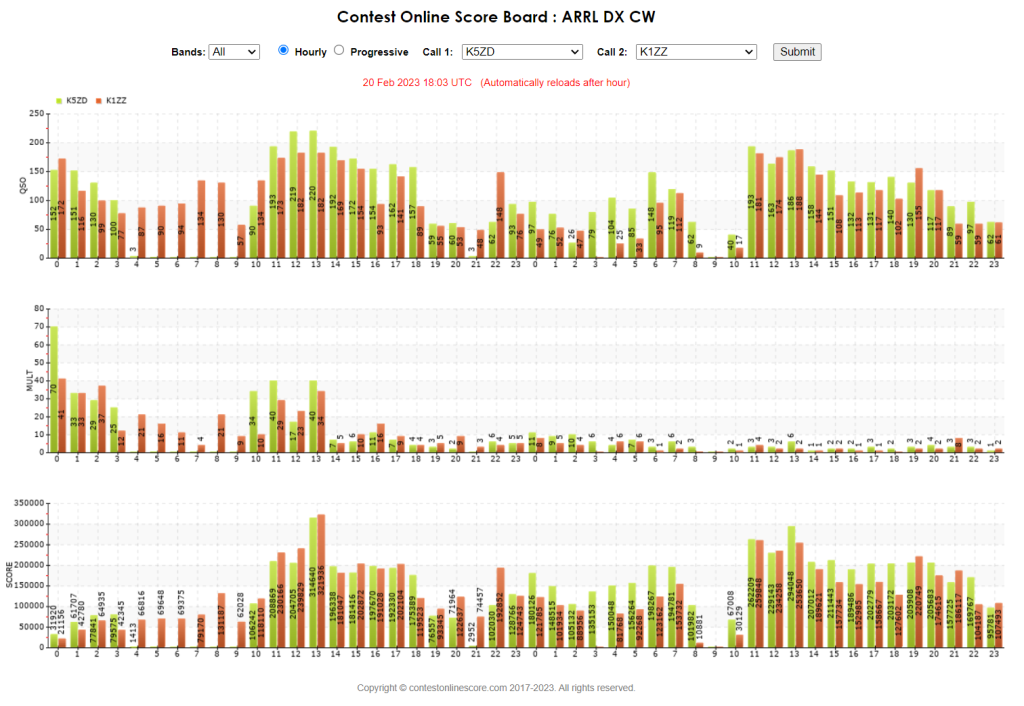2023 CQ WPX CW Contest AK1W (K5ZD)
CQWW WPX Contest, CW - 2023 Call: AK1W Operator(s): K5ZD Station: K5ZD Class: SOAB HP QTH: MA Operating Time (hrs): 18 Summary: Band QSOs ------------ 160: 0 80: 55 40: 486 20: 543 15: 1013 10: 35 ------------ Total: 2132 Prefixes = 931 Total Score = 5,748,925 Club: Yankee Clipper Contest Club
Comments
Conditions seemed fantastic for the times I was on. Especially 15m.
The main goal for the weekend was to get together with W2SC and test our WRTC station setup. Did that in the backyard on Saturday in the most perfect weather imaginable (callsign WR1TC).
Watched Formula 1 and Indy 500 on Sunday while operating. Always fun how the score takes off as the QSO totals rise.
Nice to see so much activity (and prefixes) from Ukraine.
Rates
QSO/Pref by hour and band
Hour 160M 80M 40M 20M 15M 10M Total Cumm OffTime
0000Z --+-- --+-- --+-- 38/38 --+-- --+-- 38/38 38/38 41
0100Z - - 48/38 86/81 - - 134/119 172/157
0200Z - - 136/75 - - - 136/75 308/232
0300Z - - 79/56 36/25 - - 115/81 423/313
0400Z - 7/5 14/10 30/15 15/10 - 66/40 489/353 19
0500Z - - - - - - 0/0 489/353 60
0600Z - - - - - - 0/0 489/353 60
0700Z - - - - - - 0/0 489/353 60
0800Z --+-- --+-- --+-- --+-- --+-- --+-- 0/0 489/353 60
0900Z - - 7/5 - - - 7/5 496/358 56
1000Z - - 16/9 46/29 39/15 - 101/53 597/411
1100Z - - - - 3/1 - 3/1 600/412 59
1200Z - - - - - - 0/0 600/412 60
1300Z - - - - 140/57 - 140/57 740/469 5
1400Z - - - - 42/20 - 42/20 782/489 40
1500Z - - - - - - 0/0 782/489 60
1600Z --+-- --+-- --+-- --+-- --+-- --+-- 0/0 782/489 60
1700Z - - - - - - 0/0 782/489 60
1800Z - - - - - - 0/0 782/489 60
1900Z - - - - - - 0/0 782/489 60
2000Z - - - - - - 0/0 782/489 60
2100Z - - - - - - 0/0 782/489 60
2200Z - - - - - - 0/0 782/489 60
2300Z - - - - - - 0/0 782/489 60
0000Z --+-- --+-- --+-- --+-- --+-- --+-- 0/0 782/489 60
0100Z - - - - 23/18 - 23/18 805/507 41
0200Z - - 61/19 54/24 5/2 - 120/45 925/552
0300Z - 42/6 60/32 - - - 102/38 1027/590
0400Z - 6/2 46/26 46/16 - - 98/44 1125/634
0500Z - - 17/12 46/26 1/1 - 64/39 1189/673 16
0600Z - - - - - - 0/0 1189/673 60
0700Z - - - - - - 0/0 1189/673 60
0800Z --+-- --+-- --+-- --+-- --+-- --+-- 0/0 1189/673 60
0900Z - - - - - - 0/0 1189/673 60
1000Z - - - - - - 0/0 1189/673 60
1100Z - - - - - - 0/0 1189/673 60
1200Z - - - 1/1 74/14 3/0 78/15 1267/688 8
1300Z - - - 31/14 87/21 - 118/35 1385/723
1400Z - - - - 140/31 4/1 144/32 1529/755
1500Z - - - 2/1 114/24 11/7 127/32 1656/787
1600Z --+-- --+-- --+-- 8/7 82/19 --+-- 90/26 1746/813
1700Z - - - 17/3 85/21 - 102/24 1848/837 32
1800Z - - - 4/3 104/26 8/3 116/32 1964/869
1900Z - - - 47/8 44/15 9/8 100/31 2064/900
2000Z - - - 34/7 10/4 - 44/11 2108/911 24
2100Z - - - - - - 0/0 2108/911 60
2200Z - - 2/2 17/13 5/5 - 24/20 2132/931 20
2300Z - - - - - - 0/0 2132/931 60
Total: 0/0 55/13 486/284 543/311 1013/304 35/19
Best 60 minutes: 156 @ 27-May-2023 13:10
Worked on 5 bands: CN3A NR4M
Most worked entities
160M 80M 40M 20M 15M 10M Total
K 20 165 129 252 10 576
DL 7 46 45 111 209
UA 10 34 37 81
UR 18 22 38 78
I 2 9 20 40 71
SP 17 17 36 70
VE 6 20 14 27 67

